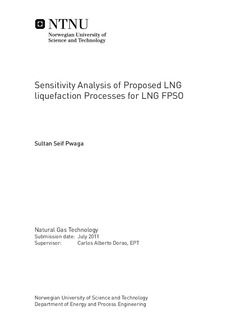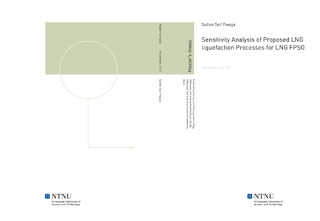| dc.contributor.advisor | Dorao, Carlos Alberto | nb_NO |
| dc.contributor.author | Pwaga, Sultan Seif | nb_NO |
| dc.date.accessioned | 2014-12-19T11:47:57Z | |
| dc.date.available | 2014-12-19T11:47:57Z | |
| dc.date.created | 2011-11-29 | nb_NO |
| dc.date.issued | 2011 | nb_NO |
| dc.identifier | 460140 | nb_NO |
| dc.identifier | ntnudaim:6372 | nb_NO |
| dc.identifier.uri | http://hdl.handle.net/11250/234536 | |
| dc.description.abstract | The four liquefaction processes proposed as a good candidate for LNG FPSO are simulated and evaluated. These processes include a single mixed refrigerant (SMR), dual mixed refrigerant (DMR), Niche LNG ( CH4 and N2 process) and dual nitrogen expander. The steady state hysys simulation of the processes were undertaken to ensure that each simulated liquefaction process was compared on the identical parameters. An in-depth optimization has not been conducted but the simulation was aimed at obtaining an optimal efficient processes based on the simulated constraints.This thesis presents the analysis of the effects of natural gas pressure, temperature and composition on the proposed liquefaction processes for LNG FPSO. During the simulations the effects were analyzed by examining specific power, power consumption and refrigerant flow rate of the proposed processes. To meet the demand of greater efficiency and large capacity for liquefaction processes, thermodynamic analysis on the liquefaction processes for LNG FPSO also has been evaluated. The analysis of specific powers, power consumptions and refrigerant flow rates on the proposed processes shows that DMR specific power is lower than that of dual nitrogen expander by 50%, Niche LNG by 41.6% and SMR by 9.6%. The power consumption of DMR is lower that of dual nitrogen expander by 54%, Niche LNG by 47.8% and SMR by 9.6%. Also DMR has lowest refrigerant flow rate than that of dual nitrogen expander by 157.6%, Niche LNG DMR by 96.4% and SMR by 30.9%The production capacity of simulated processes shows that DMR has higher production capacity per train of (0.91MTPA/Train) and dual nitrogen expander has the lowest which is (0.61MTPA/Train) based on maximum duty of one LM6000 gas turbine. DMR production capacity exceeded that of dual nitrogen expander by 33%, Niche LNG by 29.7% and SMR by 8.8%.The analysis of effect of natural gas supply temperature on the proposed processes shows that the change of natural gas supply temperature has major effect of SMR process compared to other process. The analysis shows that when natural gas supply temperature decreases from 15 to 50C SMR specific power and power consumption decrease by 14.99% and 15.10% respectively and when it is increases from 15 to 250C its specific power and power consumption increases by 39.27% and 39.19 respectively.The analysis of the effect of natural gas supply pressure on the proposed processes shows that when natural gas supply pressure decrease dual nitrogen expander has the highest effect with specific power and power consumption increases by 22.41% and 23.25% respectively and when natural gas supply pressure increases DMR has highest effect on specific power and power consumption which are 13.06% and 13.67% respectively.The effect of natural gas composition on the proposed natural gas liquefaction processes for LNG FPSO shows that for all proposed processes the change in natural gas composition may lead to increase or decrease of processes specific power, power consumptions or refrigerant flow rates. Energy efficiency is important to LNG production as feed gas is consumed in order to carry out the liquefaction process .The exergy analysis of the proposed process shows that shows that DMR process has highest useful exergy about 31% compared to the other processes. Niche LNG and dual nitrogen expander has almost same useful exergy. | nb_NO |
| dc.language | eng | nb_NO |
| dc.publisher | Institutt for energi- og prosessteknikk | nb_NO |
| dc.subject | ntnudaim:6372 | no_NO |
| dc.subject | MSGASTECH Natural Gas Technology | no_NO |
| dc.subject | | no_NO |
| dc.title | Sensitivity Analysis of Proposed LNG liquefaction Processes for LNG FPSO | nb_NO |
| dc.type | Master thesis | nb_NO |
| dc.source.pagenumber | 145 | nb_NO |
| dc.contributor.department | Norges teknisk-naturvitenskapelige universitet, Fakultet for ingeniørvitenskap og teknologi, Institutt for energi- og prosessteknikk | nb_NO |

